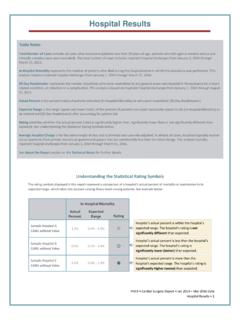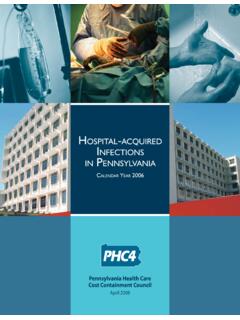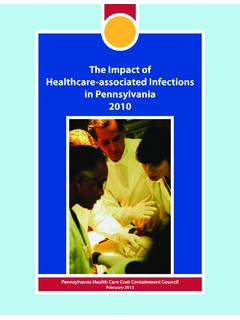Transcription of Pediatric and Congenital Heart Surgery - PHC4
1 Pediatric and Congenital Heart Surgery Pennsylvania Health Care Cost Containment Council June 2017 2012-2015 Data Pediatric and Congenital Heart Surgery About phc4 . Table of Contents The Pennsylvania Health Care Cost Containment Council ( phc4 ) is an independent state agency About this Report .. 1. charged with collecting, analyzing and reporting Understanding the Data .. 4. information that can be used to improve the quality and restrain the cost of health care in How the Normal Heart Works .. 7. the state. It was created in the mid-1980s when Benchmark Procedures Pennsylvania businesses and labor unions, in Coarctation of the Aorta Repair .. 8. collaboration with other key stakeholders, Arterial Switch Operation .. 10. joined forces to enact market-oriented health care reforms. As a result of their years of effort, Ventricular Septal Defect Repair.
2 12. the General Assembly passed legislation (Act 89 Arterial Switch Operation and Ventricular of 1986) creating phc4 . Septal Defect Repair .. 14. Norwood Procedure .. 16. phc4 's primary goal is to empower purchasers of health care benefits, such as businesses and Glenn/Hemi-Fontan 18. labor unions, as well as other stakeholders, with Fontan Procedure .. 20. information they can use to improve quality and Truncus Repair .. 22. restrain costs. Nearly 100 organizations and Complete Atrioventricular Canal Repair .. 24. individuals annually utilize phc4 's special Tetralogy of Fallot Repair .. 26. requests process to access and use data. More than 840,000 public reports on patient Total 28. treatment results are downloaded from the 29. phc4 website annually. Today, phc4 is a recognized national leader in public health care reporting.
3 phc4 is governed by a 25-member board of Acknowledgment directors representing business, labor, consumers, health care providers, insurers and phc4 wishes to thank the six children's hospitals state government. that voluntarily participated in this project by consenting to have their data publicly reported and to acknowledge the Society of Thoracic Surgeons for supplying the data. About this Report Introduction The Pennsylvania Health Care Cost Containment Council ( phc4 ) has prepared this report in cooperation with five hospitals in Pennsylvania and one in Delaware that perform cardiac Surgery on children: Alfred I. duPont Hospital for Children, Wilmington, DE. Children's Hospital of Philadelphia, Philadelphia, PA. Children's Hospital of Pittsburgh of UPMC, Pittsburgh, PA. Geisinger Medical Center Children's Hospital, Danville, PA*.
4 Penn State Children's Hospital, Hershey, PA. St. Christopher's Hospital for Children, Philadelphia, PA. Data Reported Believing that transparency and accountability, as provided by public reporting, could serve to improve The data for this report was collected care and help families of children facing cardiac Surgery and aggregated by the Society of make informed decisions, surgeons and other Thoracic Surgeons (STS). representatives from these hospitals joined with phc4 . The report includes combined outcomes to develop this outcomes report on Pediatric and for the 4-year period 2012-2015, the Congenital Heart Surgery . most recent years of data available to The hospitals participating in this project have agreed, phc4 . voluntarily, to publicly release the data included in this Reporting results over a four-year report data that was collected and aggregated by the period gives a more complete picture of Society of Thoracic Surgeons (STS).
5 Hospitals may have a hospital's experience over a longer commented on the data in this report. Comments are time period. available on phc4 's website. Results will be updated as additional years of data become available to phc4 . *The Society of Thoracic Surgeons (STS) has indicated that Geisinger Medical Center Children's Hospital was ineligible for inclusion in the operative mortality calculations included in this report; therefore, the only result reported for this facility is the total number of operations performed (Table 11 on page 28). phc4 Pediatric and Congenital Heart Surgery 2012-2015 1. About this Report The Importance of Public Reporting Those involved in the preparation of this Another important reason for public reporting is report including hospitals, surgeons, other quality improvement. Public reporting generates health care professionals and phc4 share a feedback to health care providers on their own commitment to transparency and performance and that of others in their field.
6 Accountability of cardiac procedure outcomes. Public reporting allows hospitals and surgeons to monitor and evaluate the outcomes of cardiac For patients and their families, public Surgery , and to focus their improvement efforts on reporting provides a basis for making areas that will lead to better patient care. Public informed treatment decisions. It gives them reporting aids in establishing standards and information to help determine where and benchmarks by which results can be measured. from whom they will receive that treatment. More than two decades of experience shows public reporting can be a motivating force in quality improvement efforts. phc4 Pediatric and Congenital Heart Surgery 2012-2015 2. About this Report About Congenital Heart Defects A Congenital Heart defect is a problem or the United States are living with Congenital abnormality in the Heart that is present at birth.
7 Heart Affecting nearly one out of every 100 infants in In some instances where a complete repair is the United States, or about 40,000 children per not immediately possible, multiple surgeries year, Congenital Heart defects are the most may be necessary over a period of months or common birth defect and the leading cause of years. Cardiac surgeons perform open Heart deaths related to birth , 2, 3. Surgery to stitch or patch holes in the Heart , Congenital Heart defects can affect the structure widen arteries or repair complex defects. of the Heart or the way it functions. Common According to the American Heart Association, types of Congenital Heart conditions include the mortality rate for Congenital Heart defects several that prevent blood from traveling from has been declining steadily over the past the Heart to the lungs to pick up oxygen; a hole three decades.
8 Deaths related to Congenital in one of the walls that divides the chambers or Heart defects were 3,051 in sides of the Heart thus preventing the blood from circulating properly; a too-narrow aorta, the artery that allows blood to flow from the Heart to the rest of the body; valves that do not Additional Resources close properly or are malformed; major arteries wrongly positioned; and Heart chambers that American Heart Association are too small. Not all Congenital Heart defects require Surgery . Centers for Disease Control and Prevention Congenital Heart defects range from mild to moderate to severe, from symptom-free National Institutes of Health National Heart , conditions that may go undetected for years or Lung, and Blood Institute repair themselves over time to serious cases that are immediately life threatening to the newborn.
9 Society of Thoracic Surgeons Severe conditions may call for Surgery in the early days or weeks of life or may require lifelong attention. More than 1 million adults in 1. Congenital Heart defects and CCHD. March of Dimes webite. Reviewed November 2013. Accessed March 6, 2017. 2. What Are Congenital Heart Defects? National Heart , Lung, and Blood Institute website. topics/topics/chd. Updated July 11, 2011. Accessed April 3, 2017. 3. Mozaffarian D, Benjamin EJ, Go AS, et al. Heart disease and stroke statistics 2016 Update: A report from the American Heart Association. Circulation. 2016;133(4):447-454. phc4 Pediatric and Congenital Heart Surgery 2012-2015 3. Understanding the Data What is measured in this report and why are these measures important? This report provides the public with risk-adjusted operative mortality data on ten widely performed Heart surgeries in order to help patients and families make evidence-based treatment decisions.
10 These ten benchmark procedures are reported as defined by the Society of Thoracic Surgeons. The report also looks at neonatal outcomes (data for infants up to and including 30 days old). Operative Mortality Operative mortality measures the number (or percent) of patients who died within 30 days of the Surgery (including those who died during the hospital stay in which the procedure was performed regardless of the number of days since the Surgery ). It is a key measurement in understanding surgical outcomes. Operative mortality is reported separately for ten benchmark procedures. Operative mortality rates are risk adjusted; that is, the rates account for differences among patients ( , patient age, Ten Benchmark Procedures weight, preoperative cardiogenic shock and respiratory failure). The ten benchmark procedures have been determined by the Society of Thoracic Surgeons It is important to keep in mind that there is (STS) to be the most common and standardized natural variation in mortality rates from year to surgical repairs.














